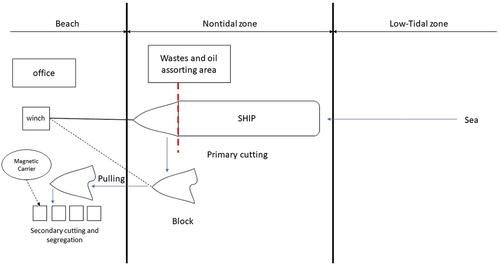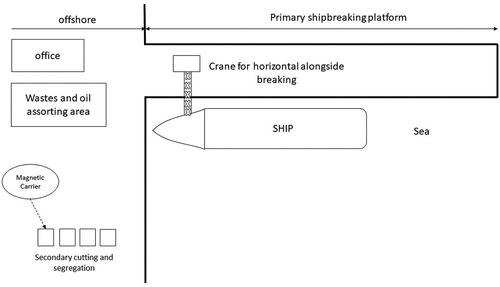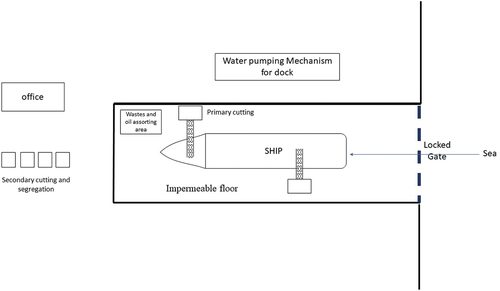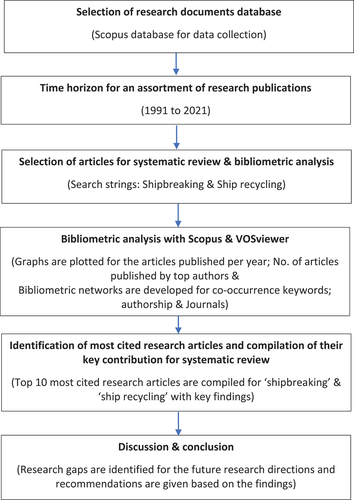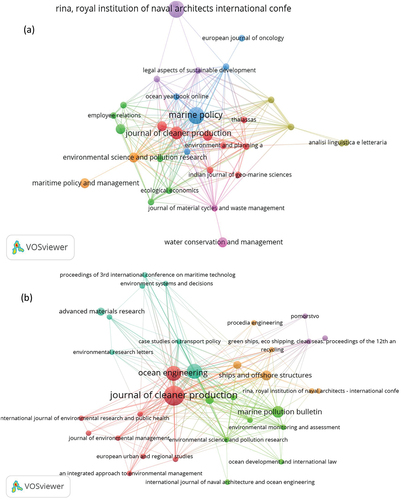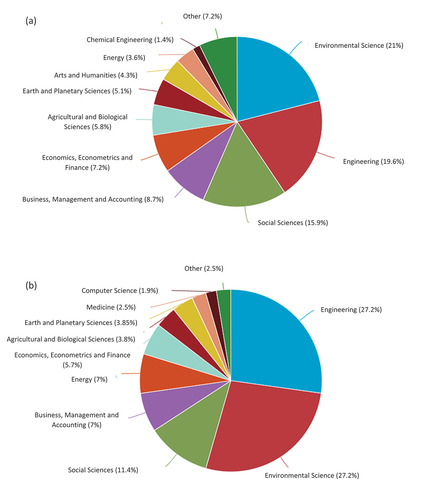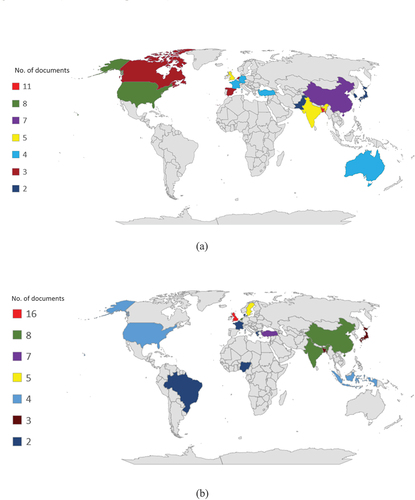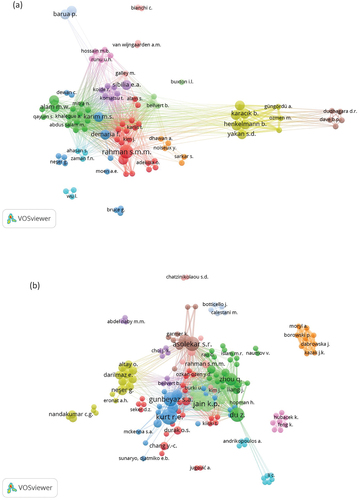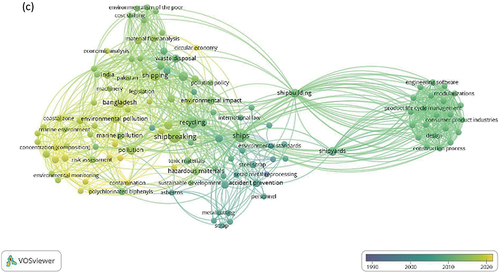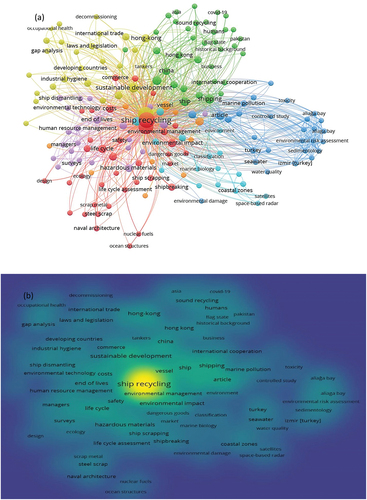ABSTRACT
Ships play a vital role in international trade for optimising transportation costs and help in boosting the economy in a globalized world. Therefore, a plethora of research has already been available in the areas related to the design, production, and operations of ships. However, little progress has been made around end-of-life (EOL) ships. For recycling the EOL ships, the terms “shipbreaking” and “ship recycling” were used in past studies and most of the time these terms can be interchangeably used in different studies. Still, there is a contextual difference that is further discussed. This study compiled the different methods of shipbreaking and ship recycling and the key regulations that facilitate the handling of EOL ships. Furthermore, it assesses the research trends of EOL ships from 1991 to 2021 through a systematic review with bibliometric analysis using the database of Scopus. For the systematic review, the topmost relevant publications are evaluated, and the key findings are compiled to find out the overall status of their contributions to shipbreaking and ship recycling research. Gaps are identified, and future research directions are discovered that might serve as a roadmap for further research development on EOL ships.
Introduction
Ships are massive engineering structures built to endure the fiercest conditions and are frequently polluted with hazardous pollutants and hydrocarbons. The average age of ships varies between 15 and 30 years depending on their type and loading conditions. When a ship’s productive life is over, it must be decommissioned, demolished, and recycled. International trade ships are vital for lowering transportation costs and sustaining the supply chain in a globalized environment. However, not much research is available on the end-of-life (EOL) of decommissioned ships. Nevertheless, EOL ships can play a significant role in economic development and capacity building at a grassroot level as more than 1000 ships are decommissioned every year, which is almost 20 million tonnes of scrap material (Choi et al., Citation2016). Once the ship is discarded, it is primarily used to extract steel, which is then repurposed and recycled into new products. This reduces the demand for virgin steel and iron resources and which in turn lowers energy consumption for steel production. Parts and other hardware available on the ships can likewise be reclaimed.
An EOL ship goes for recycling simply because the ship owner does not see any chance of utilizing the ship profitably (K. P. Jain & Pruyn, Citation2017; Stopford, Citation2008). It can be due to reasons like the operating and maintenance cost of the EOL ship is remarkably high as compared to its payload capacity and the selling price in the second-hand market is significantly lower than that of scrapping. Therefore, recycling an EOL ship as scrap metal is the most appealing choice for ship owners (Buxton, Citation1991; K. P. Jain & Pruyn, Citation2017). EOL ships go for recycling after considering the factors like (a) obsoleteness of the ship, which can be physical, technical, and regulatory obsoleteness; (b) market opportunities; (c) market forecasts for the future; and (d) scrap price (Buxton, Citation1991; K. P. Jain & Pruyn, Citation2017; Karlis & Polemis, Citation2016; Mikelis, Citation2018; Stopford, Citation2008). Most of the time, for referring to the recycling of EOL ships, either “shipbreaking” or “ship recycling” was used in past studies, and in some studies, both the terms were interchangeably used.
While shipbreaking can be sustainable as it helps in achieving a circular economy, there are worries about shipbreaking utilization by developing nations without having an established environmentally friendly ship recycling standard. As per the International Labour Organization (ILO), shipbreaking is regarded as one of the most labour-intensive and perilous jobs in the world, with extremely high numbers of injuries, casualties, and occupational diseases. Deconstructing ship structures after the ship reaches the end of its operational life cycle is a challenging and, in many circumstances, dangerous tasks (Mathew, Citation2021). Regardless of human rights and environmental risks, the industry of shipbreaking is an imperative revenue source for the government and a livelihood means for a sizable percentage of people living in South Asian countries like Bangladesh, Pakistan, and India (Alam & Faruque, Citation2014). As the task is challenging and dangerous and involves human and environmental risks, a review of available research on shipbreaking or ship recycling is exceptionally crucial to learn the current progress worldwide toward the advances in safer ship recycling practices.
When reviewing the inception and development of any research area, concept, or theory over a period of time, it is indeed crucial to understand the progression phase by considering issues like – How does the research area evolve over the period? What are the key contributions to the research area? What challenges in research are possible in the future? Is there any network possible between the significant articles? (Goyal et al., Citation2021). It is hard to organize available knowledge, comprehensively synthesize, and quantitatively analyze a research area’s major developments that feature across a timespan in the conventional literature review. It is worth mentioning that a conventional literature review is more suitable for constrained research areas (Zeng et al., Citation2021). There are few conventional review studies on ship recycling, and one was done by Sunaryo et al. (Citation2021), the study was in context with Indonesia in comparison with the leading shipbreaking countries and national as well as international regulations. There was also a chapter published in the Encyclopedia of Renewable and Sustainable Materials by (K. P. Jain & Pruyn, Citation2017) that gives an overview of the Global Ship Recycling Industry. Moreover, this study further helps academics and ship recycling practitioners (1) to acquire a status of research on the study topic, (2) recognize research gaps, (3) give a roadmap to novel research topics, and (4) establish proposed future work in the research area. These inadequacies of a conventional literature review can be overcome by doing a systematic review with bibliometric analysis (Donthu et al., Citation2020).
Thus, to explicate the global research trends and development in the area of shipbreaking or ship recycling, this study presents a systematic review with bibliometric analysis. New knowledge might be gathered by examining the available research qualitatively as well as quantitatively, along with exploring and assessing the evolution of published research. Therefore, a systematic review with a bibliometric analysis of the published documents can help to structure the currently available knowledge and also can help in identifying the research gaps and the future scope of the research area (Meyer, Citation2020). A set of statistical and mathematical approaches for displaying up-to-date and ongoing knowledge in the field of study is known as bibliometric analysis (Pritchard, Citation1969). Donthu et al. (Citation2020) have outlined the benefits of adopting bibliometric approaches for studying and reviewing the area of research such as the method might reveal research trends of the published article and journal effectiveness, author collaboration networks, and co-occurrence of keywords, also might explore the logical structure of a research area (VanderWilde & Newell, Citation2021; Verma & Gustafsson, Citation2020). The dataset used in bibliometric analyses is often extensive (number of citations and articles, keywords, and author occurrences). The interpretation of analysis usually depends on methodologies and techniques to generate the objectives like performance network results and the subjective like thematic results. Bibliometric analysis is beneficial for interpreting and charting the evolutionary intricacies and scientific information that is accumulated in an established domain by carefully organizing huge volumes of unstructured data.
In this research, the main effort is to find the answer to the following research questions: (1) How the research in shipbreaking and ship recycling has evolved over the years? (2) How are the studies on shipbreaking and ship recycling distributed among the journals and different subject areas? (3) What are the countries that give the productive research outcome in shipbreaking and ship recycling and who are the authors that are involved in productive research? (4) What are the current trends and research hotspots in shipbreaking or ship recycling research? (5) What are the top 10 most relevant publications in shipbreaking and ship recycling and what are their contribution?
As a result, the present study will be the first of its kind that has both quantitative and qualitative analyses to assess the recent trends of shipbreaking and ship recycling, as well as to identify the neglected areas to reveal underlying research areas and draw conclusions for future expansion. A range of quantitative metrics, for example, most contributing countries, top contributing authors, core journals, relevant subject areas in which work has been done, and relevant publications are explored in this research. This study may give academics and researchers a deeper understanding and direction, as well as methodically shows the key areas that need greater focus. As an outcome of this study, it is expected that the findings and recommendations will pave the way for the sustainable shipbreaking or ship recycling method/s development that will help in decarbonizing and saving the marine environment, which in turn will help to achieve the UN sustainable development goals.
After the introduction in section 1, the remaining sections are outlined; section 2 provides an overview of shipbreaking and ship recycling methods. Section 3 discusses the overview of end-of-life ship regulations. In section 4, the study method and the materials used in the study are described. Section 5 provides the bibliometric analysis results and discussions about the trends, hotspots, productive countries, and authors in the area of shipbreaking and ship recycling. In the last part of section 5, the systematic review of the top 10 most relevant papers is carried out, and the key findings are compiled. The research findings, gaps, future scope, discussion, and conclusions with recommendations are highlighted in sections 6, 7, and 8.
Overview of shipbreaking and ship recycling methods
In this section, the methods of shipbreaking and ship recycling are discussed in detail. The classification of shipbreaking and ship recycling methods is slightly different. There are eleven different ship recycling methods out of which four are conventionally as well as commercially used and known as shipbreaking methods, i.e.,, beaching, alongside/afloat, slipway, and dry-docking. Other methods like artificial reefing, hulking, SINKEX, ship museums, scuttling, wreck diving sites, and ship donation program come under ship recycling methods; however, they are not conventional or commercial methods (Dasgupta, Citation2021). Seldom, ship recycling or shipbreaking also refers to ship dismantling, ship disposal, or ship scrapping.
Much of the available studies on shipbreaking or ship recycling methods were focused on the methods that are commercially viable, especially, the beaching approach. The beaching approach is utilized to scrap nearly 2/3rd of the EOL ships around the world (Mikelis, Citation2013b). It is mainly used in Bangladesh, India, and Pakistan. Slipway methods are performed in regions that have low tidal differences, particularly in Turkey (Hougee, Citation2013). A Alongside is the technique that is mainly used in China, and it is still used in Europe in conjunction with slipways. EU countries have some ship recycling yards like Fayard, Fornæs, Smedegaarden, and Stena Recycling that are using drydock in combination with alongside and slipways. Only a few studies are available on non-commercial ship recycling methods like reefing and scuttling (Choi et al., Citation2016; LR, Citation2022).
Beaching
The term beaching is commonly applied to shipbreaking at the beach in the intertidal zone as shown in . Ships are managed onshore, as far away from the ocean side as possible (Hougee, Citation2013). Ships are mostly not able to go as far away from the ocean side as preferred with the power of their own and are often stuck on the muddy shores. These ships are then dragged up on top of the coastline utilizing cables or chains fastened to huge hoists on the coast (K. P. Jain & Pruyn, Citation2017; Sujauddin et al., Citation2015). Useful equipment and steel blocks of EOL ships are gradually cut out in this intertidal zone through cutting tools and torches. Ships become lighter and thus comfortable to drag up the coast by cranes. After ashore, the whole thing is cut down into pieces as needed by the customer. This approach is utilized to scrap more than 2/3rd of EOL ships around the world (Mikelis, Citation2018). A most important concern with shipbreaking in the intertidal zone is that any spillages of chemicals and oils are possibly carried away to the ocean by the waves (K. P. Jain & Pruyn, Citation2017; Sujauddin et al., Citation2015) causing danger to the marine environment. Nevertheless, this can be prevented by following essential procedures and considering the standard measure.
Figure 1. Schematic diagram of the beaching method (Sujauddin et al., Citation2015).

Regardless of the problems that such ship recycling sector face, the sector is thriving in the South Asian region that include Bangladesh, Pakistan, and India. Many perilous ships are disassembled at beachside yards, while the shipbreaking workers continue to encounter hazards from toxic elements in the course of shipbreaking (Rizvi et al., Citation2020).
Slipway
The slipway technique, as shown in , is a non-tidal beaching method that is an alteration of the beaching technique (LR, Citation2011; Mikelis, Citation2018). The tidal difference is the key distinction between the slipway and the beaching technique. It is performed in regions that have low tidal differences, particularly in Turkey (Hougee, Citation2013). Additional to Turkey, the slipway method is exercised in several historic ships dismantling sites, for instance, Inverkeithing in the UK (K. P. Jain & Pruyn, Citation2017; LR, Citation2011). In the US, slipways are mostly 100–120 ft wide and 400–700 ft long at the opening (USEPA, Citation2000). According to (Mikelis, Citation2013a), around 4% of the ship recycling facility utilizes the slipway approach for ship dismantling. Furthermore, with this procedure, the commercial vessel is dragged either far up the coast or on a slipway built of concrete running to the ocean, and due to the absence of tides, some hazard control is possible. This implies that many incidental spills can fairly be covered, and the elevating and retrieving procedure takes place at a relatively stable and predictable harbour (K. P. Jain & Pruyn, Citation2017; LR, Citation2011). Generally, the machinery pieces and hull are separated from the shipping vessel with the help of a winch running from the seashore. It is often assumed that a little tidal difference will enhance accessibility to the hull. In comparison to beaching, the slipway operating area provides advantages for reliable operations (Hougee, Citation2013).
Alongside or afloat
The alongside technique, also known as the floating method, quayside, or pier-side, is a practice for breaking ships that are tethered alongside jetties and afloat, quays, wharves, or anchored offshore (Hougee, Citation2013). Automatic or manual cutting equipment and cranes, like gas cutting torches or mechanical cutting tools, are utilized to deconstruct the ships. The method is “top-down,” which means that the superstructure and higher portions are removed first, and the operation then progresses down the vessel to the engine room up until just the ship hull remains (K. P. Jain & Pruyn, Citation2017; LR, Citation2011). The last portion that remains is a floating hollow hull that is also known as the canoe as shown in . While afloat, the ship is downsized to the greatest extent feasible and then either hauled the whole ship or cut up into small chunks in the drydock (Hougee, Citation2013). The afloat technique is mostly used in Belgium, China, and the United States as there is no tidal dispersing effect during shipbreaking, and the local area is more prone to toxic contamination. However, it implies that contamination can be carefully supervised, confined, and properly gutted as per the need (K. P. Jain & Pruyn, Citation2017; LR, Citation2011).
Dry dock
This method is intended for ship disposal in a dock and as the interaction takes place in dry docks, it is the most reliable and environmentally friendly techniques. While such a system eliminates the risk of inadvertent contamination, the procedure is too expensive. EOL ships are deconstructed on a floating dock, or drydock which has an impermeable floor structure and locked gate mechanism as shown in (Hougee, Citation2013). As everything is kept within the dock, this procedure is the cleanest and greenest of all the shipbreaking/ship recycling methods because the possibilities of accidentally damaging adjacent surroundings are nearly zero (Lee, Citation2012). The dockyard is washed prior to being flooded for the next ship’s breakdown to avoid contamination (K. P. Jain & Pruyn, Citation2017; LR, Citation2011). The sole disadvantage of this process is that it is the most expensive method of shipbreaking/ship recycling, which makes it the least popular. Another disadvantage is that the dry dock might be of limited size. Thus, large ships might not be possible to recycle using the dry dock method (Sornn-Friese et al., Citation2021).
Artificial reefing
It is built by submerging the non-reusable ship, deep in seawater or seaward. Careful steps are attempted to guarantee that the disposal vessel is without any toxic material or electric means before it is forced to drown. The artificial fabricated reefs extend a safe living space for countless types of marine species (Lin & Zhang, Citation2015). The counterfeit reefs are utilized to give shelter and food to marine life and help in advancing the spawning possibilities. This type of ship disposal procedure is utilized by several nations.
Hulking
This course of ship dismantling determines that in water, the hull of a dismantled vessel remains untouched, whilst other useful ship components do not remain unblemished. The specific ship hull can drift in the sea, however, it doesn’t take part in cruising. For this, it is important to remove and dispense a wide range of toxic materials before the hull is permitted to decompose in the sea (Dasgupta, Citation2021).
SINKEX
The SINKEX ship-breaking procedure includes a shoot-down exercise led by the Navy to practice and prepare military hardware, rocket launching, torpedo exactness, and so on. The objective ship is exploded in military instructional courses in which these ships are considered as shooting aims (USDT, Citation2021). The training ships are exploded into bits and pieces by utilizing military arm vessels, which prompted the sinking of the ship and its breaking. This is a compelling method for testing military firearms without harming new ships. The Navy planned real-time target training exercises, while idle ships were converted into a mound of rubbish. According to sources, the US Navy oversees these activities in remote areas of the California coast, Hawaii, Puerto Rico, and Kauai (Dasgupta, Citation2021).
Ship museums
Navy warships with actual historical relevance go to ship museums where they serve as memorials after completing their cruise life when they are not in good operational condition. The gallery ships assist to meet people’s educational needs while also displaying history in its most authentic form, which is both thrilling and engaging for museum visitors (Dasgupta, Citation2021). The antique ships are themselves encapsulations of valiant battles and underappreciated but very remarkable personalities, and they are compensating for the brave sailors’ memories. There are a few ship museums across the world that employ this unique disposal system.
Scuttling
Scuttling is a technique for purposefully sinking an abandoned ship by releasing the ship’s valves or making a hole in the ship with low-level explosions and allowing water to fill up its structure (Dasgupta, Citation2021; Devault et al., Citation2017).
Wreck diving sites
It is an imitation of marine diving locations set up purposefully by sinking EOL ships. For divers, the wreck might serve as a training ground or can become a profitable business by arranging sporting amenities. Beforesinkinga ship, ship, should be free of a variety of dangerous fluids, lubricants, and chemicals, such as PCBs. The ship is cleaned of potentially toxic synthetic compounds. Useful items, such as copper wire, might be utilized to compensate for the costs of making the ship safe for sinking (Dasgupta, Citation2021).
Ship donation program
In this program, multiple non-profit foundations or the public are given the option to acquire different abandoned vessels as a ship disposal method. So, it serves the purpose of both the public and the Navy. The EOL ships of the Navy can be kept as monuments or used in non-profit exercises. This program is specially introduced for the disposal of prestigious old navy vessels (Dasgupta, Citation2021).
Overview of end-of-life ship regulations
There were three main events that changed the entire system of handling the EOL ships. The first event, which led to the foundation of each regulation was the Basel Convention (Citation1989); the second was the Hong Kong Convention (HKC, Citation2009) and the third was the European Union Ship-Recycling Regulation (EUSRR, Citation2013). The three events and other key regulations, which had played roles to draft policies for ship recycling and shipbreaking are documented in according to the timeline.
Table 1. Key regulations and conventions for EOL ships.
The Basel Convention is the basis for all the regulations that can govern ship recycling, which is accomplished coincidentally by controlling the transboundary movement of hazardous wastes and ensuring the subsequent environmentally responsible treatment and disposal (BC, Citation1989; BPLC, Citation1999). At the global level, the management of Ship Recycling Facilities (SRF) and specified regulatory measures are mandated. Nevertheless, efforts were made to allay these concerns by the HKC. The HKC is significant because it establishes the ground for correct authorization of SRF, mandates survey, and certification of ships, imposes obligations with regard to Inventory of Hazardous Materials (IHM) reports, and enforces compliance with Port State Controllers (HKC, Citation2009).
After the HKC, the European Parliament, and the Council of November 20, 2013 on ship recycling formed EUSRR, which played a significant role in the improvement of standards at ship recycling facilities in a short period of time. It started at the regional level and now is accepted globally. The statute deals with the concerns related to both the environment and human health (EUSRR, Citation2013). It also sets global standards for the proper management of onboard hazardous items as well as the guidelines for ship recycling facility conditions. To bring the standards within each of the SRF located in the EU and in developing countries to parity, it is noteworthy that the EUSRR makes no discrimination between the OECD and non-OECD countries (CIDEU, Citation2019).
Method and materials
In this study, a systematic review with bibliometric analysis of shipbreaking and ship recycling has been done using the Scopus database and VOSviewer software. There are two most reliable databases for journal searches, one is Scopus, and the other is the Web of Science. According to Gavel and Iselid (Citation2008), in journal-title overlap analysis, Scopus covers 84% of documents that are present in the Web of Science, whereas the Web of Science merely covers only 54% of Scopus documents. This implies that Scopus covers more documents, and there is a more probable document available here for the same searches. These outcomes were also validated by the research done by other researchers (Vieira & Gomes, Citation2009). Nevertheless, analogies between Scopus and the Web of Science in the bibliometric analysis do not represent that one is better than the other (Sánchez et al., Citation2017). Thus, the Scopus database is used in this study for systematic review as well as for bibliometric analysis. The methodological framework is shown as a flowchart in .
After selecting the Scopus database, the time horizon of three-decades, i.e., from 1991 to 2021 has been considered for the assortment of research publications. As the data is collected in April 2022, the year 2022 is not considered as it is not near to completion. The articles are searched for EOL ships by considering the search strings like “shipbreaking” and “ship recycling.” The systematic review and bibliometric analysis use the Scopus search string “TITLE-ABS-KEY” which searches in the article’s title, abstract, and keywords. The search string shows 89 documents for “shipbreaking,” but the keyword “article” is excluded as it is not a specific keyword for shipbreaking then only 71 documents are shown in the results, and when the search string “ship recycling” is searched, 578 documents have appeared as search string considering “ship” and “recycling” as a separate word; however, for the exact keyword “ship recycling” the number of documents reduces to 72. Thus, for bibliometric analysis, 71 documents are considered for shipbreaking, and 72 documents are considered for ship recycling.
After that, the Scopus dataset is analyzed in VOSviewer software for bibliometric analysis. Bibliometric analysis can be performed using a variety of advanced tools and software. BibExcel, VOSviewer, and Histcite are the most used software. For Scopus data, Histcite does not provide support for bibliometric analysis (Fahimnia et al., Citation2015). To execute a simple analysis, BibExcel has a complicated user interface that needs training and expertise (Fahimnia et al., Citation2015). Thus, VOSviewer is used in this study as it is freely available software that has a user-friendly interface, and the outcome of the results has better graphics. Using VOSviewer, the research analysis is conducted as per the pre-determined criteria in the form of research questions that are given in section 1. Next, a systematic review is done by identifying the 10 most relevant documents of shipbreaking as well as ship recycling and by compiling their key contributions. Finally, a section on discussion and conclusion is presented discussing the research gaps that are identified to pave the way for future research direction. Further recommendations are also given based on the findings.
Bibliometric analysis of research trends
The research trends for the datasets of 71 shipbreaking documents (44 journal articles, 6 review papers, 7 book chapters, 9 conference papers, 2 books, 1 conference review, 1 note, and 1 brief survey) and 72 ship recycling documents (48 journal articles, 4 review papers, 2 book chapters, 17 conference papers, and 1 conference review) are analyzed, and the results are discussed in this section. The bibliometric study normally involves a statistical evaluation of all types of data using scientific datasets (e.g., Scopus dataset) and a computational approach (e.g., VOSviewer) (Reza et al., Citation2021). Therefore, it has proven to be a feasible method for conducting a systematic and critical review of the published research in various areas of study (Cabeza et al., Citation2020). The research questions that are formulated in section 1 are considered here to perform the bibliometric analysis and finally, the results of the analysis are linked to the research questions (RQ) to find the answers.
RQ1: how has the research in shipbreaking and ship recycling evolved over the years?
In the search string of Scopus, more than three decades, i.e., from 1991 to 2021 is considered as the time frame to study shipbreaking and ship recycling. The result of the bibliometric analysis that illustrates the research progression of shipbreaking and ship recycling is plotted as a line graph shown in .
Initially, for the EOL ship disposal, the term “shipbreaking” is used. Moreover, from 2005 onwards, many researchers started using the term “ship recycling” for the disposal of EOL ships which is an umbrella term, and shipbreaking is a commercial part of it. Although, there are researchers who still use the term shipbreaking, however, in the past decade, the studies that using the term ship recycling have increased manifolds, and it is no surprise that researchers are now more inclined toward using ship recycling in their research documents as Ministries of Transport/Shipping and IMO (International Maritime Organization) prefer using ship recycling for EOL ship disposal (K. Jain, Citation2018; K. P. Jain & Pruyn, Citation2017). If considering the general trend of both shipbreaking and ship recycling, then there was a continuous increase in the number of documents published per year and in 2021, the highest number of ship recycling documents were published. It is expected that this trend will increase further as organizations like IMO are working towards UN sustainable development goals and some studies are going on that are funded by IMO and the European Union countries to develop a method of ship recycling that is safer and greener, and the output of these research may increase the number of documents. In 2020, the IMO initiative on Safe and Environmentally Sound Ship Recycling in Bangladesh (SENSREC) has been executed and going into the phase III to make ship recycling in Bangladesh safer and greener, and for this purpose Government of Norway investing around 1.5 million USD. This would open the way for Bangladesh to become a partner of the IMO Hong Kong Convention which helps to establish standards worldwide for safe and ecologically sound ship recycling (IMO, Citation2020).
RQ2: how are the studies on shipbreaking and ship recycling distributed among the journals and different subject areas?
The document publication sources have been assessed to recognize the journals that have the higher number of documents. The top threepublisher for shipbreaking are Marine Policy; proceedings of RINA International conference – Recycling of ships and other marine structures; and Journal of Cleaner Production, which constitutes nearly 18.3% of the total number of shipbreaking documents, whereas the top three sources for ship recycling documents are Journal of Cleaner Production; Resources, Conservation, and Recycling; and Ocean Engineering, which accounts for 30.5% of total publications. Next, if citations are considered, then the three most-cited journals for shipbreaking are Ecological Economics; Marine Policy; and Journal of Cleaner Production 86, 70 and 66 citations, having respectively. While for ship recycling, the most cited three journals are Marine Pollution Bulletin; Journal of Cleaner Production; and Resources, Conservation, and Recycling 182, 122, and 111 citations, having respectively.
represents the bibliographic coupling analysis results of Scopus publication sources for shipbreaking and ship recycling which is a network of different clusters. This network cluster is formed by analyzing the relatedness of the different documents and each document is assigned to only one cluster to avoid overlapping) (van Eck & Waltman, Citation2017).
The number of clusters can be identified by assorted colour coding, and that implies shipbreaking has seven publication clusters and ship recycling has five clusters. The journals that fall in the same colour cluster are more related to a node. The node in the network signifies the number of documents published by a specific source/journal, i.e., the bigger the node, the higher the number of documents published by the journal. The connecting line in-between the nodes signify a co-citation relationship, which means if the length of the line is shorter and thicker, the co-citation relationships between the journals are strong.
Finally, shows the subject area distribution in shipbreaking and ship recycling. If the publications that are related to shipbreaking are considered, then only three subject areas (i.e., Environmental Science; Engineering; Social Sciences;) have covered more than half of the publications and most of the work was done in the area of Environmental Science as most of the researcher considered shipbreaking as an environmental hazard, and most of the available literature is focused on pointing out the issues associated with shipbreaking activities without providing a sustainable solution for it. If ship recycling publications are considered, then only two subject areas cover more than half of the publications and both the subject areas in Engineering, and Environmental Science cover 27.2% of total publications, respectively.
RQ3: what are the countries that give the productive research outcome in shipbreaking and ship recycling and who are the authors that are involved in productive research?
From 1991 to 2021, 28 countries have contributed to the area of shipbreaking, and nearly, 30% of the publications are published only by three countries named Bangladesh, the United States, and China.
According to the affiliated country of the first author, illustrates the top 15 countries that contributed to shipbreaking published documents and from the first glance, one can observe that most of the countries that have contributed to shipbreaking research are either leading shipbreaking countries or leading ship-owning countries. Bangladesh is the topmost contributor to the research in the area of shipbreaking with 11 publications and is also one of the leading countries in shipbreaking. Bangladesh is focused on this research area as shipbreaking helps in sustaining its economy, and it is estimated that the average annual revenue of the shipbreaking sector in Bangladesh is 1.5 billion dollars (Das & Ali Shahin, Citation2019). Despite being one of the leading shipbreakers in the world, Bangladesh did not formally recognize this sector as an industry until 2006. In Bangladesh, this sector has grown substantially at the expense of environmental deterioration and occupational health issues in shipbreaking labour. Even with human rights violations and environmental issues, the shipbreaking sector is an important source of livelihood for a sizable percentage of the people as well as a means of tax revenue for the government of Bangladesh (Alam & Faruque, Citation2014).
If the research on ship recycling is considered, then 27 countries contributed to ship recycling research out of which only 2 countries, i.e., the United Kingdom (UK) and China, add more than 25% to ship recycling publications. While considering the first author’s affiliation country, shows the top 15 countries that contributed to ship recycling articles. Now, researchers prefer using ship recycling instead of shipbreaking as Ministries of Transport/Shipping and the IMO use the same (K. P. Jain & Pruyn, Citation2017). The UK is the topmost contributor in the area of ship recycling with 16 publications, and most of the research was done considering EUSRR and HKCand both the regulations not only influenced the research output of the UK, but encouraged several EU countries to involved in ship recycling research. After the UK, the second-highest research output was given by China, India, and the Netherlands, which contributed the same number of publications, i.e., eight publications. Apart from leading ship recycling countries like India and Bangladesh, there are some developing countries like Indonesia, Brazil, and Nigeria that started taking interests in ship recycling as these countries’ research were focused on finding the opportunities in ship recycling as a contributor to their economies.
Next, the result of the bibliographic-coupling analysis of authors that are associated with shipbreaking and ship recycling research are shown in . Shipbreaking has 71 documents published that have 140 authors and ship recycling has 72 aritcles with 176 authors that form a network. Both networks have 12 clusters, and each cluster is represented by a specific colour, which signifies the close association between the authors that are represented by nodes. The association can be internal collaboration like the same project/institution/region/country, or it can external for example the author has cited the research of another author, i.e., co-citation relationship. The red cluster has the maximum number of authors for both shipbreaking and ship recycling, which means 19 and 24 authors in the red cluster, respectively.
The authors' bibliometric analysis is done by giving weightage to the number of documents the authors have published which means the bigger the size of the node, the greater number of documents published by an author. shows that if shipbreaking research is considered, then Rahman S.M.M., Alam M.W., and Demaria F. have contributed a greater number of documents as compared to other authors and indicates that when ship recycling research has been considered then Jain K.P., Asolekar S.R., Kurt R.E., Du Z, and Gunbeyaz S.A. are top contributors. The concept of distance between the nodes and the thickness of network lines is the same as discussed before, i.e., if the distance between the nodes is less than the authors that represent the nodes are strongly associated, and if the thickness of the network line is more prominent, then nodes connected to that line have significant co-citation relationship.
RQ4: what are the current trends and research hotspots in shipbreaking and ship recycling research?
In this section, the research hotspot and current trends of shipbreaking and ship recycling research had been identified using co-occurrence analysis of keywords, which is the most meaningful analysis in terms of bibliometrics. In this analysis, a network visualization of the relationship among the keywords has been created using the VOSviewer software. Although, in total 554 and 884 keywords appeared in shipbreaking and ship recycling publications, respectively; however, the analysis is done on 125 and 178 keywords only as the minimum occurrence of a keyword are taken to be 2 to evaluate the research hotspots and research trends. In bibliometric co-occurrence analysis, each keyword is represented by a node, whereas the diameter of the node illustrates the occurrence of the keyword. The bigger the node is, the more occurrences the keyword has (van Eck & Waltman, Citation2017).
reveals the network visualization of 125 keywords of published research on shipbreaking has five clusters with specific colour coding. The first cluster is red that has 37 keywords and most of the keywords are associated with the shipbreaking sector and scrap metal. The next cluster is a green cluster, which is the second cluster that has 28 keywords and most of them are linked to marine pollutants and their risk assessments. The third cluster is the blue cluster, which comprises 24 closely correlated keywords, and the majority of the keywords are associated with ship designs and shipbuilding. The fourth cluster, i.e., yellow, is mostly about waste management and has 21 keywords. The fifth cluster, which is the last cluster, is coded in purple colour and has 15 keywords that are loosely related to legislation and regulatory framework. Next, shows the density visualization of shipbreaking keywords that are depicted by their labels in the same manner that they are in the network visualizations. The density of keywords at each point in the density visualization is indicated by a colour that ranges from blue to green to yellow by default. The closer a point’s hue to yellow, the greater the weightage of the keyword in its immediate vicinity (van Eck & Waltman, Citation2009). From the density visualization, the research hotspot of shipbreaking can easily be identified. Finally, illustrates the overlay visualization, which is the same as the network visualization and the only difference is the colour of the nodes, which is as per the scale given in the lower right corner of the figure. The colour of the nodes represents the average year of the keywords (Mahieu et al., Citation2018). Therefore, overlay visualization helps to identify the recent research trends in the area of shipbreaking, and from the overlay visualization figure, it can be easily recognized that the researchers were recently focused on risk assessment of shipbreaking and applying circular economy to shipbreaking activities.
Figure 11. Bibliometric co-occurrence analysis of shipbreaking publications keywords (a) Network visualization (b) Density visualization and (c) Overlay visualization.
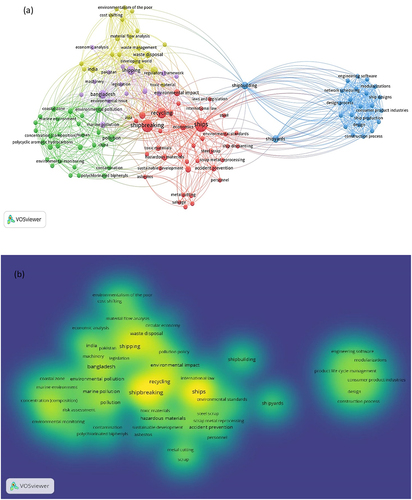
In , the network visualization of 178 keywords of ship recycling research has been presented which is divided into seven clusters. The first one is a red cluster, which has 37 keywords that are roughly related to the life cycle assessment of ships. The second one is the green one, which comprises 36 keywords that are related to international laws and policies. The next one is the blue one, which is the third cluster that has 28 keywords that are closely correlated with ship recycling in Turkey. The fourth cluster is a yellow one that has 27 keywords that are mostly related to sustainable development, laws, and legislation. The fifth cluster is the purple one which has 23 keywords that are somehow related to surveys and hazard assessments. The sixth cluster is sky blue, which has 10 keywords that are mostly related to the management of coastal zones. The seventh one is the last one which is an orange cluster that has 10 keywords that are not related to each other. represents the density visualization of ship recycling keywords that helps in identifying the hotspot of ship recycling research as discussed earlier. Similarly, shows the overlay visualization that helps to figure out the latest trends of research in ship recycling, which is the gap analysis of Indonesian ship recycling practices and the impact of COVID-19 on ship recycling.
RQ5: what are the top 10 most relevant publications in shipbreaking and ship recycling and assess their contribution?
In this section, a systematic review is done of the top 10 most relevant shipbreaking and ship-recycling research in the and the respectively to evaluate their contributions by compiling the key findings. A systematic review that is done while considering the number of citations as the scholarly impact of published documents with greater citation counts on a certain topic is becoming more relevant (Reza et al., Citation2021). The number of citations received is a common statistic for evaluating the impact of a particular publication in an area of study. It may be assumed that a growing number of citations shows a prominent level of significance. Thus, recognizing highly cited publications may aid in finding extraordinary contributions in a field and highlighting potential study subjects (Wali et al., Citation2022; Wali et al., Citation2021).
Table 2. Top 10 highly cited papers for shipbreaking from 1991 to 2021.
Table 3. Top 10 highly cited papers for ship recycling from 1991 to 2021.
Research findings and gaps
After reviewing the title, abstract, keywords, and results of 143 Scopus documents (71 shipbreaking and 72 ship recycling documents), the key findings of the systematic review with bibliometric analysis are compiled in this section, which focuses on the research issues that are related to the disposal of the EOL ships as described below:
All the articles reviewed describe the shipbreaking and ship recycling methods for the disposal of the EOL ships. A total of 12 methods of ship recycling are explained briefly and out of which, four are commercially used and are known as shipbreaking methods. Even in commercial ones, beaching is the only method that disposes 2/3rd of the EOL ships around the world.
The articles reviewed also provide an overview of significant regulations that were passed over the years to make the EOL ship recycling activities sustainable and it is identified that there are three main events that have changed the way of handling an EOL ship. The first event is the Basel Convention that was held in 1989 which deals with controlling the transboundary movement of hazardous wastes, the second is the HKC that was held in 2009 which imposes IHM reports and the third is the EUSRR, which sets the global standards for the proper management of onboard hazardous items and also sets the guidelines for ship recycling facility conditions in 2013.
The Scopus database is used for systematic review and bibliometric analysis, and it is found that only 71 shipbreaking and 72 ship recycling documents were published in the last three decades, i.e., 1991 to 2021.
The first research question is about the evolution of shipbreaking and ship recycling, and it is found that initially, the term “shipbreaking” is used and after 2005, many researchers started using the term “ship recycling” for the disposal of EOL ships.
The second research question is about shipbreaking and ship recycling research distributions among the journals and different subject areas. The output of the analysis shows that Marine Policy; proceedings of RINA International Conference on Recycling of Ships and Other Marine Structures; and Journal of Cleaner Production are the top three sources of documents related to shipbreaking and for ship recycling, the top three document sources are the Journal of Cleaner Production; Resources, Conservation and Recycling journal; and Ocean Engineering journal. Also, for both shipbreaking and ship recycling terms, most of the documents published are in engineering or environmental science subject areas.
The third research question is about countries and authors that give the most research outcomes, and the analysis shows that Bangladesh and the United Kingdom are the top contributor countries of shipbreaking and ship recycling research, respectively, and the top authors of shipbreaking and ship recycling research are Rahman S.M.M. and Jain K.P. respectively.
The fourth research question is about the current trends and research hotspots in shipbreaking and ship recycling research and the analysis shows three hotspots: network, density, and overlay visualization for both shipbreaking and ship recycling. Network visualization shows the keyword clusters, density visualization shows the shipbreaking and ship recycling research hotspots and overlay visualization depicts the latest trends in the shipbreaking and ship recycling research area.
The last and the fifth question is about the contribution of the top 10 most relevant published documents and for answering the question, key findings are compiled by doing a systematic review of the top 10 most cited documents in a tabular form.
Based on the findings, a few research gaps are identified in the research areas of shipbreaking and ship recycling and these gaps might shape the future directions of research as discussed below:
From the review, it was found that there are numerous areas in which research was published to make EOL ship recycling sustainable. Still, more than 2/3rd of EOL ships around the world are recycled through the beaching method, which is currently not a sustainable practice, and the dry-dock, which is a sustainable ship recycling method is costly to use for recycling large ships. Although there are studies available on green ship recycling however, there is no study available that optimizes the most used beaching method or develops an alternative method that is sustainable and cost-effective and can be used to recycle large ships on a commercial scale.
Most of the relevant legal regulations came from the Basel Convention, the HKC, and the EUSRR. However, there is no framework available on how to achieve sustainable ship recycling, which is both efficient as well as cost-effective.
Most of the studies were done to identify the sustainability issues concerning the marine environment, occupational health, working conditions of humans, and soil contamination levels in the beaching method, which is the most commercial method of ship recycling. However, research documents are not available that provide a realistic solution for these sustainability issues.
Implications and future scope of the research
The most important implication of this research is to provide insights into the status of research in the area of shipbreaking and ship recycling and give future directions to academicians and ship recycling practitioners for further development in these areas. So, by undertaking the research gaps, some future research work has been proposed below:
Automation and robotics solutions can be implemented for metal cutting and to make ship recycling sustainable and cost-effective.
Optimization of workflow in shipyards will help to provide the standards for shipbreaking and ship recycling.
Critical factors can be compiled that influence shipbreaking and ship recycling, and a framework can be developed that further helps in sustainable and cost-effective ship recycling.
Research can be done on the development of shipbreaking or ship recycling methods that overcome sustainability issues and can be used commercially which will help in saving marine environments, soil, and human life.
The research is done using the Scopus database, future studies can use the other databases for comparable studies like Web of Science, dimensions, Lens, etc.
Discussion and conclusion
Most of the past studies, which advocate sustainable ship recycling, are mainly focused on methods that are not commercially viable as they are expensive and only recycle several small ships and few studies that consider the commercial method mostly discuss the issues related to it without providing realistic solutions to it. This study identifies research gaps which imply that future research should address the ship recycling issues without dealing with them superficially and provide solutions that are cost-effective as well as environment friendly. In this study, a systematic review with bibliometric analysis is done to structure the huge volumes of unstructured literature. This research well recognizes the evolutionary paradigm of shipbreaking and ship recycling and develops the networks and maps the accumulative research data. This study has established the fundamentals for future research and development in meaningful conduct as it enables the researchers to (1) acquire the status of the research area, (2) identify gaps in the available literature, (3) create novel and innovative research ideas, and (4) compiled the relevant and key research contributions. As a result, the research offers a set of findings, research gaps, and future research directions that may be integrated to provide a helpful picture for the advancement of research in shipbreaking and ship recycling of EOL ships. In conclusion, shipbreaking and ship recycling activities are essential for a sustainable marine industry and for obtaining financial gain from the EOL ships. In many developing countries, it plays a vital role in the growth of the country’s economy. Although, the ILO defines shipbreaking as one of the most dangerous occupations in the world. However, when these activities are done according to policies that are formulated by the Basel convention, HKC and EUSRR then it will help in decarbonization and achieving a circular economy, and UN sustainable development goals.
List of acronym and abbreviation
| EOL | = | End-of-life |
| PCBs | = | Polychlorinated biphenyl |
| HKC | = | Hong Kong convention |
| EUSRR | = | European Union Ship-Recycling Regulation |
| ILO | = | International Labour Organization |
| TITLE-ABS-KEY | = | title, abstract, and keywords |
| IMO | = | International Maritime Organization |
| SENSREC | = | Safe and Environmentally Sound Ship Recycling |
| PAHs | = | Polycyclic aromatic hydrocarbons |
| LCA | = | Life cycle assessment |
| IHM | = | Inventory of Hazardous Materials |
| SRF | = | Ship Recycling Facilities |
Acknowledgments
The authors would like to acknowledge the financial support provided by the University of Plymouth to conduct this research within the School of Engineering, Computing, and Mathematics.
Disclosure statement
No potential conflict of interest was reported by the author(s).
References
- Abdullah, H. M., Mahboob, M. G., Banu, M. R., & Seker, D. Z. (2013). Monitoring the drastic growth of ship breaking yards in Sitakunda: A threat to the coastal environment of Bangladesh. Environmental Monitoring and Assessment, 185(5), 1–31. https://doi.org/10.1007/s10661-012-2833-4
- Alam, S., & Faruque, A. (2014). Legal regulation of the shipbreaking industry in Bangladesh: The international regulatory framework and domestic implementation challenges. Marine Policy, 47, 46–56. https://doi.org/10.1016/j.marpol.2014.01.022
- BAN. (1995). Third meeting of the conference of the parties to the basel convention. http://www.basel.int/TheConvention/ConferenceoftheParties/Meetings/COP3/tabid/6152/Default.aspx
- BC. (1989). Basel convention on the control of transboundary movements of hazardous wastes and their disposal. http://www.basel.int/TheConvention/Overview/tabid/1271/Default.aspx
- BPLC. (1999). Basel protocol on liability and compensation for damage resulting from transboundary movements of hazardous wastes and their disposal basel. http://www.basel.int/Default.aspx?tabid=1345
- Buxton, I. L. (1991). The market for ship demolition. Maritime Policy & Management, 18(2), 105–112. https://doi.org/10.1080/03088839100000034
- Cabeza, L. F., Frazzica, A., Chàfer, M., Vérez, D., & Palomba, V. (2020). Research trends and perspectives of thermal management of electric batteries: Bibliometric analysis. Journal of Energy Storage, 32, 101976. https://doi.org/10.1016/j.est.2020.101976
- Chang, Y. C., Wang, N., & Durak, O. S. (2010). Ship recycling and marine pollution. Marine Pollution Bulletin, 60(9), 1390–1396. https://doi.org/10.1016/j.marpolbul.2010.05.021
- Chatzinikolaou, S. D., & Ventikos, N. P. (2015). Holistic framework for studying ship air emissions in a life cycle perspective. Ocean Engineering, 110, 113–122. https://doi.org/10.1016/j.oceaneng.2015.05.042
- Choi, J. K., Kelley, D., Murphy, S., & Thangamani, D. (2016). Economic and environmental perspectives of end-of-life ship management. Resources Conservation and Recycling, 107, 82–91. https://doi.org/10.1016/j.resconrec.2015.12.007
- CIDEU. (2019). Commission Implementing Decision (EU) 2019/995 of 17 June 2019 amending Implementing Decision (EU) 2016/2323 establishing the European List of ship recycling facilities pursuant to Regulation (EU) No 1257/2013 of the European Parliament and of the Council (Text with EEA relevance. https://eur-lex.europa.eu/legal-content/EN/TXT/?uri=CELEX%3A32019D0995
- Das, J., & Ali Shahin, M. (2019). Ship breaking and its future in Bangladesh. Journal of Ocean and Coastal Economics, 6(2). https://doi.org/10.15351/2373-8456.1110
- Dasgupta, S. (2021). 10 Types of ship disposal techniques. Retrieved April 12, 2022, from https://www.marineinsight.com/guidelines/10-types-of-ship-disposal-techniques/
- Demaria, F. (2010). Shipbreaking at Alang-Sosiya (India): An ecological distribution conflict. Ecological Economics, 70(2), 250–260. https://doi.org/10.1016/j.ecolecon.2010.09.006
- Devault, D. A., Beilvert, B., & Winterton, P. (2017). Ship breaking or scuttling? A review of environmental, economic and forensic issues for decision support. Environmental Science and Pollution Research, 24(33), 25741–25774. https://doi.org/10.1007/s11356-016-6925-5
- DirectiveEUPC. (2008). Directive 2008/98/EC of the European parliament and of the council of 19 November 2008 on waste and repealing certain directives (Text with EEA relevance). https://eur-lex.europa.eu/legal-content/EN/TXT/?uri=celex%3A32008L0098
- Donthu, N., Kumar, S., & Pandey, N. (2020). A retrospective evaluation of marketing intelligence and planning: 1983–2019. Marketing Intelligence & Planning, 39(1), 48–73. https://doi.org/10.1108/mip-02-2020-0066
- EUSRR. (2013). Regulation (EU) No 1257/2013 of the European Parliament and of the Council of 20 November 2013 on ship recycling and amending Regulation (EC) No 1013/2006 and Directive 2009/16/EC Text with EEA relevance. https://eur-lex.europa.eu/eli/reg/2013/1257/oj
- Fahimnia, B., Sarkis, J., & Davarzani, H. (2015). Green supply chain management: A review and bibliometric analysis. International Journal of Production Economics, 162, 101–114. https://doi.org/10.1016/j.ijpe.2015.01.003
- Gavel, Y., & Iselid, L. (2008). Web of Science and Scopus: A journal title overlap study. Online Information Review, 32(1), 8–21. https://doi.org/10.1108/14684520810865958
- Goyal, S., Chauhan, S., & Mishra, P. (2021). Circular economy research: A bibliometric analysis (2000–2019) and future research insights. Journal of Cleaner Production, 287, 125011. https://doi.org/10.1016/j.jclepro.2020.125011
- Gregson, N., Crang, M., Botticello, J., Calestani, M., & Krzywoszynska, A. (2016). Doing the ‘dirty work’ of the green economy: Resource recovery and migrant labour in the EU. European Urban and Regional Studies, 23(4), 541–555. https://doi.org/10.1177/0969776414554489
- Hiremath, A. M., Tilwankar, A. K., & Asolekar, S. R. (2015). Significant steps in ship recycling vis-a-vis wastes generated in a cluster of yards in Alang: A case study. Journal of Cleaner Production, 87(1), 520–532. https://doi.org/10.1016/j.jclepro.2014.09.031
- HKC. (2009). The Hong Kong international convention for the safe and environmentally sound recycling of ships. https://www.imo.org/en/About/Conventions/Pages/The-Hong-Kong-International-Convention-for-the-Safe-and-Environmentally-Sound-Recycling-of-Ships.aspx
- Hougee, M. (2013). Shades of green in the ship recycling industry: An assessment of corporate end-of-life vessel policies and practices. Wageningen University. https://library.wur.nl/WebQuery/theses/2032602
- IMO. (2015, May 15). Guidelines for the development of the inventory of hazardous materials. https://www.imorules.com/MEPCRES_269.68.html
- IMO. (2020). Ship recycling in Bangladesh leaps forward with third phase of key project signed [Press release]. https://www.imo.org/en/MediaCentre/PressBriefings/pages/23-SENSREC-Phase-III.aspx
- Jain, K. (2018). Five facts about sustainable ship recycling. https://www.maritime-executive.com/editorials/five-facts-about-sustainable-ship-recycling
- Jain, K. P., & Pruyn, J. (2017). An overview of the global ship recycling industry. In M. S. J. Hashmi (Ed.), Reference Module in Materials Science and Materials Engineering (pp. 626–647). Elsevier. https://doi.org/10.1016/B978-0-12-803581-8.10396-0.
- Karim, M. S. (2015). Prevention of pollution of the marine environment from vessels: The potential and limits of the international maritime organisation. Springer International Publishing.
- Karlis, T., & Polemis, D. (2016). Ship demolition activity: A monetary flow process approach. Scientific Journal of Maritime Research, 30(2), 128–132. https://doi.org/10.31217/p.30.2.5
- Lee, M. A. (2012). Korean perspectives on ship recycling [ Master of Science in Environmental Management and Policy]. Lund University. https://lup.lub.lu.se/luur/download?func=downloadFile&recordoid=3128532&fileOId=3128542
- Lin, C., & Zhang, L. (2015). Habitat enhancement and rehabilitation. 333–351.
- LR. (2011). Ship recycling: Practice and regulation today. http://www.lr.org/Images/ShipRecycling_040711_tcm155-223320.pdf
- LR. (2022). Lloyd’s Register verified ship recycling facilities. https://www.lr.org/en/lloyds-register-verified-ship-recycling-facilities/
- Mahieu, R., van Eck, N. J., van Putten, D., & van den Hoven, J. (2018). From dignity to security protocols: A scientometric analysis of digital ethics. Ethics and Information Technology, 20(3), 175–187. https://doi.org/10.1007/s10676-018-9457-5
- Mathew, E. (2021). Ship recycling, market imperfections and the relevance of a consortium of ship recycling nations in the Indian subcontinent. Journal of International Maritime Safety, Environmental Affairs, and Shipping, 5(2), 23–31. https://doi.org/10.1080/25725084.2021.1921994
- Meyer, T. (2020). Decarbonizing road freight transportation – a bibliometric and network analysis. Transportation Research Part D: Transport and Environment, 89, 102619. https://doi.org/10.1016/j.trd.2020.102619
- Mikelis, N. (2013a). An analysis of the European regulation on ship recycling. http://www.gmsinc.net/gms/pdf/2013-11-18_GMS_Tokyo_Conf/The_Eu_Regulation_on_ship_recycling.pdf
- Mikelis, N. (2013b). Ship recycling markets and the impact of the Hong Kong convention [Paper presented]. International Conference on Ship Recycling, Malmo, Sweden, World Maritime University.
- Mikelis, N. (2018). The Recycling of Ships.
- Moen, A. E. (2008). Breaking basel: The elements of the basel convention and its application to toxic ships. Marine Policy, 32(6), 1053–1062. https://doi.org/10.1016/j.marpol.2008.03.002
- Neşer, G., Kontas, A., Ünsalan, D., Altay, O., Darilmaz, E., Uluturhan, E., Küçüksezgin, F., Tekoğul, N., & Yercan, F. (2012). Polycyclic aromatic and aliphatic hydrocarbons pollution at the coast of Aliağa (Turkey) ship recycling zone. Marine Pollution Bulletin, 64(5), 1055–1059. https://doi.org/10.1016/j.marpolbul.2012.02.019
- Neşer, G., Kontas, A., Ünsalan, D., Uluturhan, E., Altay, O., Darilmaz, E., Küçüksezgin, F., Tekoğul, N., & Yercan, F. (2012). Heavy metals contamination levels at the Coast of Aliağa (Turkey) ship recycling zone. Marine Pollution Bulletin, 64(4), 882–887. https://doi.org/10.1016/j.marpolbul.2012.02.006
- Neşer, G., Ünsalan, D., Tekoǧul, N., & Stuer Lauridsen, F. (2008). The shipbreaking industry in Turkey: Environmental, safety and health issues. Journal of Cleaner Production, 16(3), 350–358. https://doi.org/10.1016/j.jclepro.2006.08.018
- OECDdecision. (1992, April 6). 1992 OECD decision C (92)39/Final on the control of transboundary movements on wastes destined for recovery operations. https://legalinstruments.oecd.org/public/doc/221/221.en.pdf
- Pritchard, A. (1969). Statistical bibliography or bibliometrics. Journal of Documentation, 24, 348–349.
- Rahman, S. M. M., Handler, R. M., & Mayer, A. L. (2016). Life cycle assessment of steel in the ship recycling industry in Bangladesh. Journal of Cleaner Production, 135, 963–971. https://doi.org/10.1016/j.jclepro.2016.07.014
- Rahman, S. M. M., & Kim, J. (2020). Circular economy, proximity, and shipbreaking: A material flow and environmental impact analysis. Journal of Cleaner Production, 259, 120681. https://doi.org/10.1016/j.jclepro.2020.120681
- RegulationEUPC. (2006). Regulation (EC) No 1013/2006 of the European Parliament and of the Council of 14 June 2006 on shipments of waste. https://eur-lex.europa.eu/legal-content/EN/ALL/?uri=celex%3A32006R1013
- Reza, M. S., Mannan, M., Wali, S. B., Hannan, M. A., Jern, K. P., Rahman, S. A., Muttaqi, K. M., & Mahlia, T. M. I. (2021). Energy storage integration towards achieving grid decarbonization: A bibliometric analysis and future directions. Journal of Energy Storage, 41, 102855. https://doi.org/10.1016/j.est.2021.102855
- Rizvi, M. J., Islam, M. R., Adekola, O., & Margaret, O. N. (2020). A sustainable shipbreaking approach for cleaner environment and better wellbeing. Journal of Cleaner Production, 270, 122522. https://doi.org/10.1016/j.jclepro.2020.122522
- Rousmaniere, P., & Raj, N. (2007). Shipbreaking in the developing world: Problems and prospects. International Journal of Occupational and Environmental Health, 13(4), 359–368. https://doi.org/10.1179/oeh.2007.13.4.359
- Sánchez, A. D., de la Cruz Del Río Rama, M., & García, J. Á. (2017). Bibliometric analysis of publications on wine tourism in the databases Scopus and WoS. European Research on Management and Business Economics, 23(1), 8–15. https://doi.org/10.1016/j.iedeen.2016.02.001
- Sharma, R., & Kim, T. W. (2010). Development of a logic-based product life-cycle management (LBPLM) system for shipbuilding industry-conceptual development. Journal of Ship Production, 26(4), 231–251. https://doi.org/10.5957/jspd.2010.26.4.231
- Sornn-Friese, H., Roth, E., Sofev, P., Kaiser, B., Sinding, K., Vagsheyg, H., Eikås, A., Høivik, H., Langhorst, K., Larsen, F. T., Olsen, T., Paulsen, M. D., Lange, B., & Lauridsen, F. S. (2021). Creating circular economy clusters for sustainable ship recycling in Denmark. CBS MARITIME.
- Stopford, M. (2008). Maritime economics 3e.
- Sujauddin, M., Koide, R., Komatsu, T., Hossain, M. M., Tokoro, C., & Murakami, S. (2015). Characterization of ship breaking industry in Bangladesh. Journal of Material Cycles & Waste Management, 17(1), 72–83. https://doi.org/10.1007/s10163-013-0224-8
- Sunaryo, S., Djatmiko, E., Fariya, S., Kurt, R., & Gunbeyaz, S. (2021). A gap analysis of ship-recycling practices in Indonesia. Recycling, 6(3). https://doi.org/10.3390/recycling6030048
- UN. (1992, June 3-14). United nations conference on environment and development. https://www.un.org/en/conferences/environment/rio1992
- USDT. (2021). Ship disposal program. https://www.maritime.dot.gov/national-defense-reserve-fleet/ship-disposal-program/sinkex
- USEPA. (2000). A guide for ship scrappers: Tips for regulatory compliance. http://purl.access.gpo.gov/GPO/LPS15690
- VanderWilde, C. P., & Newell, J. P. (2021). Ecosystem services and life cycle assessment: A bibliometric review. Resources Conservation and Recycling, 169, 105461. https://doi.org/10.1016/j.resconrec.2021.105461
- van Eck, N. J., & Waltman, L. (2009). Software survey: VOSviewer, a computer program for bibliometric mapping. Scientometrics, 84(2), 523–538. https://doi.org/10.1007/s11192-009-0146-3
- van Eck, N. J., & Waltman, L. (2017). Citation-based clustering of publications using CitNetExplorer and VOSviewer. Scientometrics, 111(2), 1053–1070. https://doi.org/10.1007/s11192-017-2300-7
- Verma, S., & Gustafsson, A. (2020). Investigating the emerging COVID-19 research trends in the field of business and management: A bibliometric analysis approach. Journal of Business Research, 118, 253–261. https://doi.org/10.1016/j.jbusres.2020.06.057
- Vieira, E. S., & Gomes, J. A. N. F. (2009). A comparison of Scopus and web of science for a typical university. Scientometrics, 81(2), 587–600. https://doi.org/10.1007/s11192-009-2178-0
- Wali, S. B., Hannan, M. A., Ker, P. J., Rahman, M. S. A., Mansor, M., Muttaqi, K. M., Mahlia, T. M., & Begum, R. A. (2022). Grid-connected lithium-ion battery energy storage system: A bibliometric analysis for emerging future directions. Journal of Cleaner Production, 334, 130272. https://doi.org/10.1016/j.jclepro.2021.130272
- Wali, S. B., Hannan, M. A., Reza, M. S., Ker, P. J., Begum, R. A., Rahman, M. S. A., & Mansor, M. (2021). Battery storage systems integrated renewable energy sources: A biblio metric analysis towards future directions. Journal of Energy Storage, 35, 102296. https://doi.org/10.1016/j.est.2021.102296
- Yılmaz, A., Karacık, B., Yakan, S. D., Henkelmann, B., Schramm, K. W., & Okay, O. S. (2016). Organic and heavy metal pollution in shipbreaking yards. Ocean Engineering, 123, 452–457. https://doi.org/10.1016/j.oceaneng.2016.06.036
- Zeng, J., Qu, J., Ma, H., & Gou, X. (2021). Characteristics and trends of household carbon emissions research from 1993 to 2019: A bibliometric analysis and its implications. Journal of Cleaner Production, 295, 126468. https://doi.org/10.1016/j.jclepro.2021.126468

